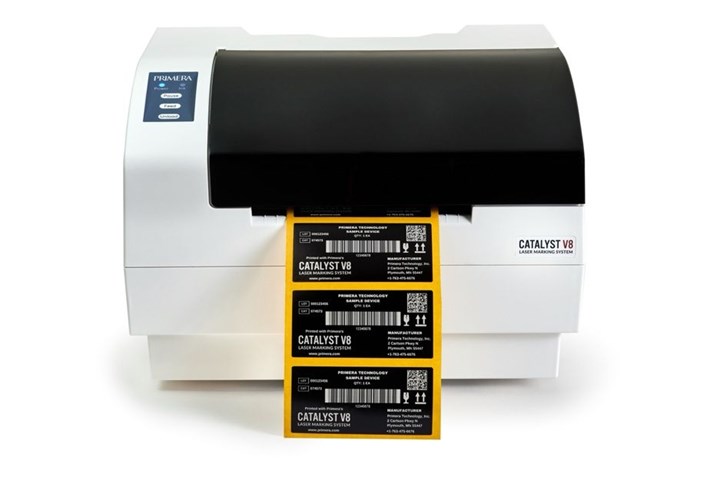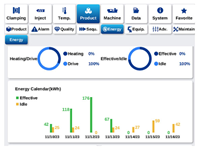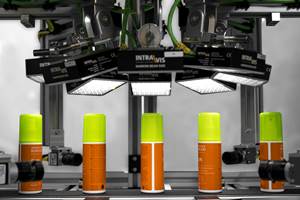Cost-Performance Industrial Fiber Laser-Based Label Marking System
Primera Technology’s new Catalyst Laser Marking System allows for fast, easy production of highly durable, synthetic labels.
A new industrial fiber laser-based marking system that is said to allow for the fast and easy production of highly durable, synthetic labels for a wide range of tough-service applications is being commercially launched April 1, by , Plymouth, Minn., a leading maker of specialized digital printing equipment.
Labels produced with laser marking systems, including the new Primera’s Catalyst Laser Marking System, are typically used to replace metal plates or far less durable labels produced by resin thermal transfer printers on polyester substrates. Typical applications requiring such high-durability labels include the U.S. Department of Defense's IUID program, UDI labels for medical devices and healthcare equipment, automobile VIN and under-hood part number, warning and instruction labels, aerospace and solar panel labels, serial tags for outdoor power equipment, vehicle and marine spare parts, building tools and materials, and much more.

Text, graphics, and linear or 2D/3D bar codes are laser-imaged onto Color Laser Film (CLF), which was developed and is manufactured specifically for extreme indoor and outdoor applications. CLF labels are extraordinarily robust and do not require extra lamination to withstand extended exposure to UV light, chemicals, liquids, and temperatures of up to 300C/572F.
Instead of ink, Catalyst uses a bundle of 2, 4, or 8 fiber-coupled laser diodes along with matched, patent-pending high-precision lenses to image onto CLF. Bundled fiber lasers have never before been used in a roll-fed, desktop laser label imager, making Catalyst unique in its class. After imaging the CLF material, Catalyst's built-in proprietary Digital Die-Cutting system cuts the labels to any shape, eliminating the need for pre-die-cut labels. Unlike other laser-based marking systems, it uses a knife blade instead of the laser beam to cut out the labels. This reportedly eliminates the need for a smoke and fume extraction system, saving even more money on the initial equipment costs and the on-going costs and bother of periodic filter changes, cleaning, and other maintenance.
Compared to Yag and CO2 lasers, Catalyst's imaging method boasts several significant advantages for producing highly durable labels, including:
&²Ô²ú²õ±è;â–ª Cost. Catalyst's price for the entry-level V2 model with two laser diodes is priced at just $2995 – about one-tenth of the cost of machines with identical speed and imaging quality. Two faster versions are also available: V4 with four laser diodes for twice the speed of V2 sells for $3995 and, V8 with eight laser diodes for twice the speed of V4 sells for $5995.
&²Ô²ú²õ±è;â–ª Simple mechanics. Instead of a more traditional but far more complex and expensive computer-controlled galvanometer with beam steering mirrors, Catalyst was designed more like a standard industrial label printer such as Primera's LX910 Color Label Printer. This approach results in a far less complicated machine with no special maintenance or on-going calibration required.
&²Ô²ú²õ±è;â–ª Ease of operation. Catalyst installs on a PC as a standard Windows printer. Any popular Windows-based label creation software can be used to send image files. No special operator training or certification is required.
Said Primera’s v.p. of sales & marketing Mark D. Strobel, "We are excited to introduce this ground-breaking new laser-based label imaging system.For companies that need labels for use in harsh and severe-service environments, and even for mission-critical applications, Catalyst is the most affordable and easiest to use laser-marking label printer available."
A printer driver for Windows 10+ is available online for download. Also available for download is easy-to-use label design and printing software from Seagull Scientific called BarTender®2021 for Windows. Wired USB and Ethernet connectivity is standard. Wireless Ethernet is available with the use of an inexpensive (under $50.00) Universal Ethernet to WiFi adapter.
Related Content
Cobot Takeout System for Shuttle Machines
NPE2024: Proco Machinery upgrades its Robopik bottle takeout system for shuttle blow molders with the addition of a collaborative robot.
Read MoreAdvanced Inspection of Bottles and Labels
NPE2024: Intravis shows new system for full label inspection on round, randomly oriented bottles; and redesigned bottle inspection system with more modular design.
Read MoreTransforming Laser Marking Operations With Collaborative Robotic Automation
FOBA partners with Flexxbotics and Universal Robots.
Read MoreSACMI’s PET Bottle and Labeling Machinery Integrated Into Omnia Techologies
SACMI Bottling and Labelling are now subunits of Omnia’s ACMI.
Read MoreRead Next
See Recyclers Close the Loop on Trade Show Production Scrap at NPE2024
A collaboration between show organizer PLASTICS, recycler CPR and size reduction experts WEIMA and Conair recovered and recycled all production scrap at NPE2024.
Read MoreMaking the Circular Economy a Reality
Driven by brand owner demands and new worldwide legislation, the entire supply chain is working toward the shift to circularity, with some evidence the circular economy has already begun.
Read More










